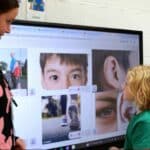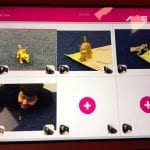SEND specialist Chris Williams, outlines a unique audio-visual approach that supports children’s ability to articulate their thoughts and progress their learning.
As a teacher, and as a learner, I have always believed in the old adage: ‘A picture is worth a thousand words.’ Whatever the situation, pictures can capture ideas, memories, key facts… in fact, anything at all.
The first time I was invited to address a large conference I had to stand up and present to several hundred people. This wasn’t a natural environment to me but for every one of my slides I had created a little picture. I didn’t get flustered. I didn’t stammer. I knew exactly what I wanted to say and was able to deviate from my carefully rehearsed script to engage directly with my audience, making the whole thing much more lively, relevant and engaging. My visual prompts kept me on track.
I am a visual person, but experience has shown me that I am not alone in finding that this kind of strategy works. Whatever age group I am working with – with or without SEND – I always start with visuals and take it from there. When I am supporting sixth formers to prepare university presentations, they follow exactly the same processes that I use when I am working with little ones. The picture acts as a visual cue, which is linked to language.
That consistent approach can be used at all levels. When my SEND children use images to support their speaking work, their fluency is off the scale.Reading Thinking in Pictures by Temple Grandin gave me an insight into the power of images in terms of understanding and communication from an autism perspective. However, images underpin all of my work, not just with students with autism, and serve as the springboard for a wide range of other approaches designed to accelerate and reinforce learning.
The methods I use are grounded in evidence of impact and I pay particular attention to the Education Endowment Foundation Teaching and Learning Toolkit, which summarises research outcomes and acts as a valuable signpost for schools introducing new methods and ideas.The following are proven to be amongst the most effective approaches and interventions presented in the EEF toolkit.
- Communication and language approaches
- Collaborative learning
- Digital technology
- Meta-cognition and self-regulation
- Feedback and assessment
Communication based interventions are very much at the top of my list. I firmly believe that developing children’s ability to express themselves orally pays rich dividends when it comes to progressing their reading and writing, and indeed other aspects of their learning too.
chatta is a teaching approach which has been developed and evaluated in hundreds of schools and early years settings. Based on the premise that good speaking skills are the essential prerequisite for subsequent progress in all areas of learning, the approach makes it easy for teachers and support staff to create audio-visual resources that are meaningful to the child. Adult descriptions of pictures showing the child engaged in an enjoyable classroom activity or outdoor event provide a powerful model for the child to listen to, and they can record their own responses too. Even the most reticent children love playing these back to hear their own voices, providing ample opportunities for the adult to reinforce learning and encourage the child to say even more.These exchanges can be shared with parents and carers, keeping them informed about what their child is doing in school and giving them a chance continue to the dialogue at home.
To find out more about how chatta training and resources can change outcomes for the children you work with please get in touch: [email protected] 0845 003 0896 www.chattalearning.com
Former SENCO and special school teacher, Chris Williams is a consultant and trainer and the co-creator of chatta, training to support a powerful and versatile teaching approach for pre-school and Early Years settings. chatta is being launched nationally in Scotland in January 2017.



